Multi-Micro/Nanolayer Films Based on Polyolefins: New Approaches from Eco-Design to Recycling
Abstract
:1. Introduction
2. Experimental Section
2.1. Materials and Sample Preparation Methodology
2.2. Cast Forced Assembly Multilayer Coextrusion
2.3. Mechanical Recycling Processes
- Grinding: The multilayer films were ground with a blade grinder, leading to the production of small flakes.
- Cast-film extrusion: The flakes obtained from the grinding of multilayer films were used as raw material to feed the extruder. Monolayer films with a thickness of 200 µm were obtained as a result, with an extrusion temperature of 210 °C. The same extruder as the one shown in Figure 1 was used without the feedblock and multiplier elements, in order to obtain monolayer films.
- Extrusion (mini twin-screw extruder): Flakes obtained from the grinding of multilayer films were used as raw material to feed the extruder. The extrusion process was performed at 210 °C. Then, the obtained compounds were pelletized in a cutting machine. The extrusion process was performed using a HAAKE mini co-rotating twin-screw (mini CTW) machine (Thermo-Scientific, Waltham, MA, USA).
- Injection molding: Depending on the recycling process used, flakes (obtained by grinding) or pellets (prepared with the mini twin-screw extruder) were used as raw material to feed the injection-molding machine. A piston injection-molding HAAKE™-Mini-jet was used in order to obtain flat rectangular specimens for tensile testing. Sample dimensions of 2 × 4 mm2 (thickness × width) were obtained. The temperature of injection was 220 °C and the injection pressure was 550 bars for 8 s. Then a packing pressure of 450 bars was applied for 8 s.
- R1→ Steps applied: Grinding + Monolayer cast film extrusion
- R2→ Steps applied: Grinding + Injection molding
- R3→ Steps applied: Grinding + Mini twin-screw extrusion+ Injection molding
2.4. Mechanical and Morphological Characterization
Tensile Testing
2.5. Scanning Electron Microscopy
3. Results and Discussion
3.1. PE/PP Multilayer Systems
3.1.1. Characterization of the Mechanical Properties
Effect of the Number of Layers
Effect of a Compatibilizer
Influence of the Recycling Process System
3.1.2. Morphological Characterization of the Recycled Multilayer Films
3.2. PE/PS Multilayer Systems
3.2.1. Study of the Mechanical Properties
Effect of the Number of Layers and Composition
Influence of the Recycling Process on the Mechanical Properties
3.2.2. Morphological Characterization of the Recycled and Neat LDPE/PS Films
4. Conclusions
Author Contributions
Funding
Institutional Review Board Statement
Informed Consent Statement
Data Availability Statement
Acknowledgments
Conflicts of Interest
Appendix A. Mechanical Properties and Morphological Characterization of PE/PP Monolayer Films
Appendix A.1. Tensile Properties
| Films (wt/wt) | Tensile Strength at Yield (MPa) | Tensile Strength at Break (MPa) | Elongation at Break (%) |
|---|---|---|---|
| 100% PE | 6.7 ± 0.6 | 44.3 ± 6 | 562.6 ± 30 |
| 90% PE 10% PP | 8.2 ± 0.5 | 19.5 ± 2 | 228.1 ± 35 |
| 83%PE 10%PP 7% EOC | 2.19 ± 0.2 | 16.4 ± 4 | 240.0 ± 48 |
Appendix A.2. Morphological Characterization with SEM

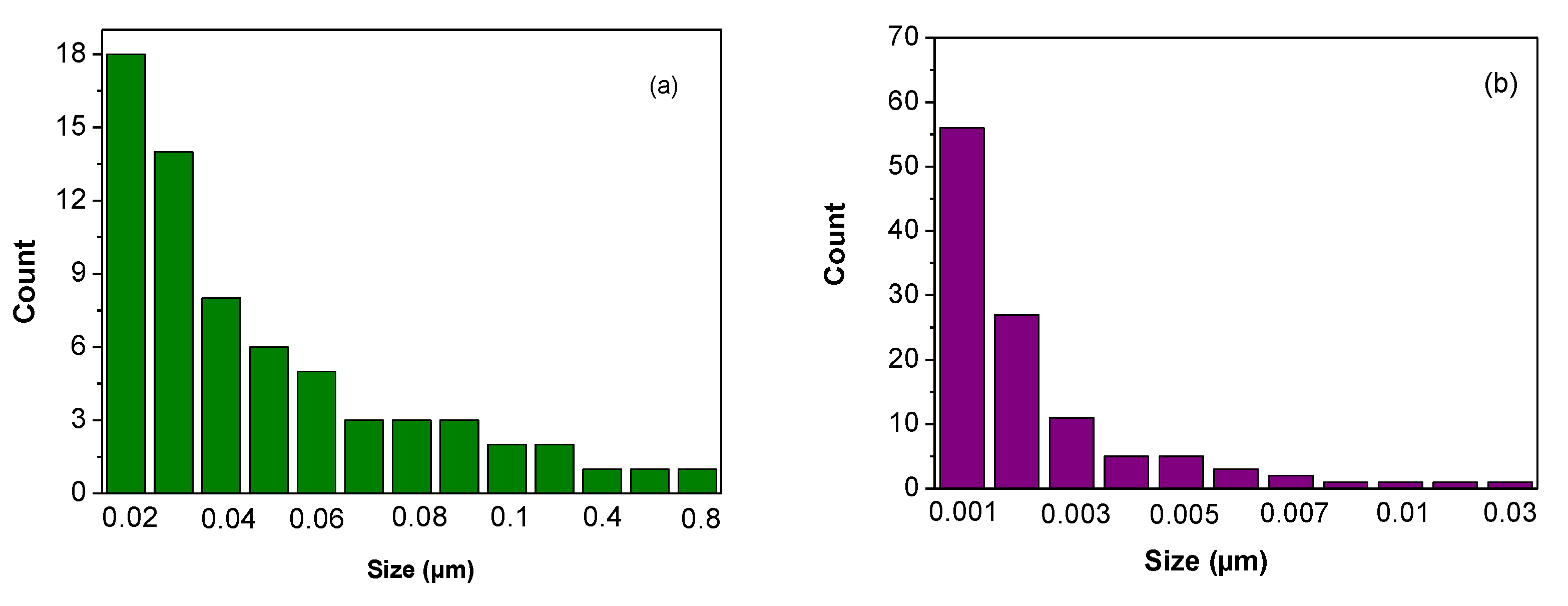
Appendix B. LDPE/PS Systems: Effect of the Number of Layers on the Crystalline Orientation of LDPE
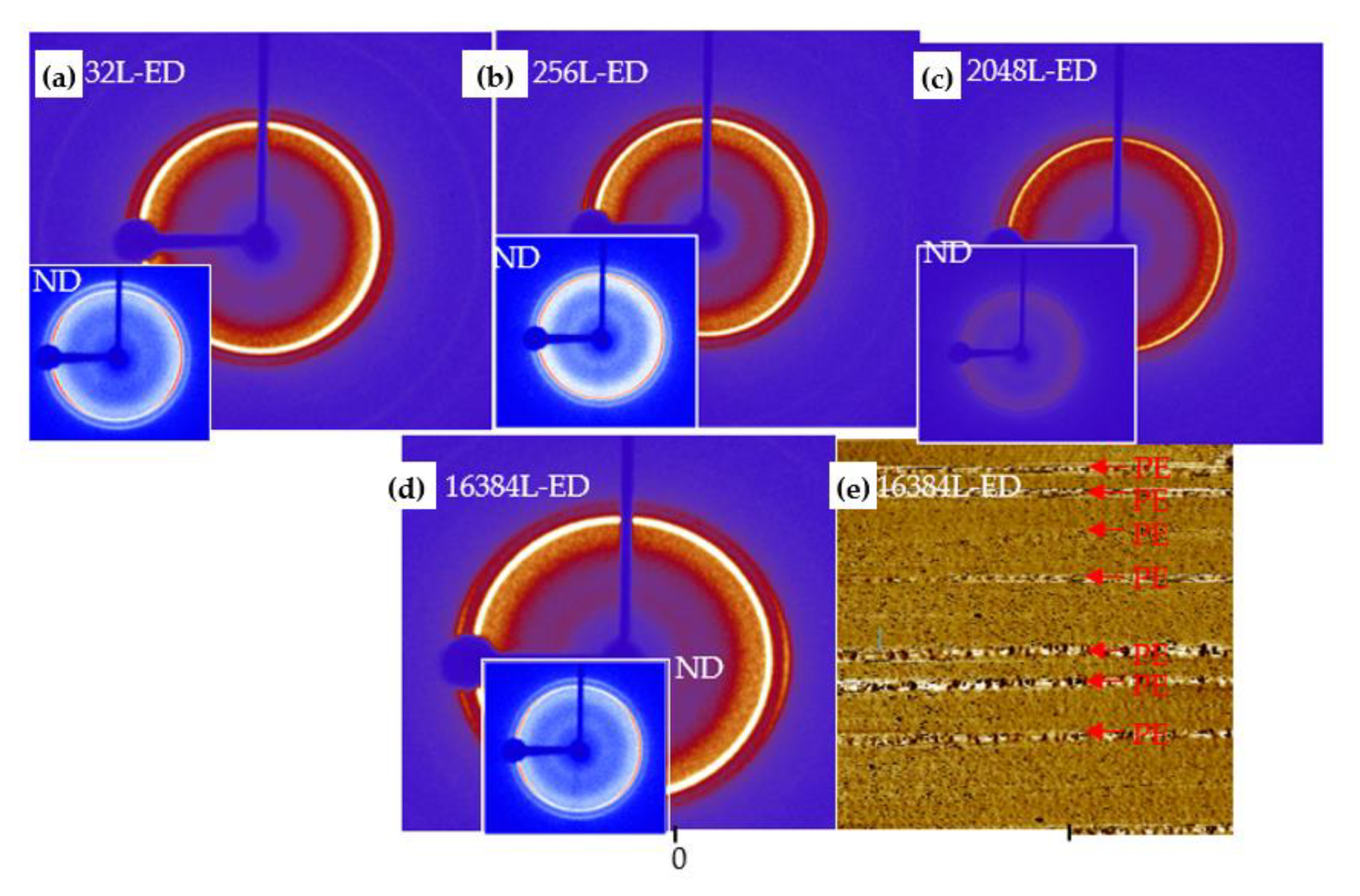
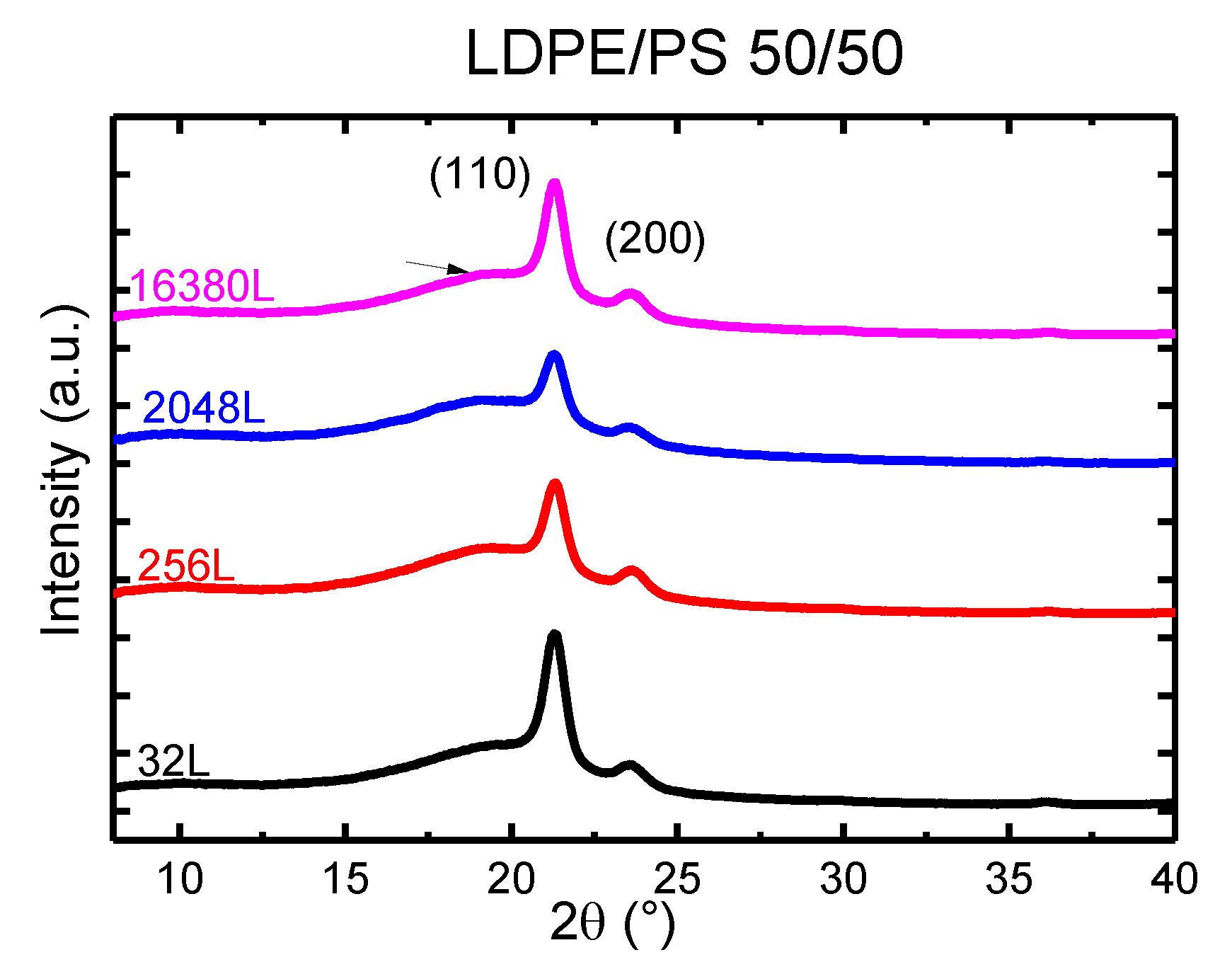
Appendix C. Thermal Characterization of the LDPE/PS Systems with Dynamic Scanning Calorimetry (DSC)
| Sample | LDPE/PS—50/50 | ||||
|---|---|---|---|---|---|
| Tm (°C) | ΔHm (J/g) | Xc, DSC (%) | hN | L (nm) | |
| LDPE | 112 | 117 | 40 | - | 9.47 |
| 32 | 110.5 | 24.5 | 8.5 | 6250 nm | 9.01 |
| 256 | 111.7 | 29.7 | 10 | 781 nm | 9.38 |
| 2048 | 110.6 | 31 | 10.5 | 195 nm | 9.04 |
| 16380 | 110 | 26.5 | 9 | 97 nm | 8.81 |
| Blend | 113 | 25 | 8.5 | - | 9.81 |
References
- Plastics Europe and EPRO. “Plastics—The Facts 2016”. Available online: www.plasticseurope.de/informations (accessed on 31 March 2020).
- Horodytska, O.; Valdés, F.; Fullana, A. Plastic flexible films waste management—A state of art review. Waste Manag. 2018, 77, 413–425. [Google Scholar] [CrossRef] [PubMed]
- Bondon, A.; Lamnawar, K.; Maazouz, A. Experimental investigation of a new type of interfacial instability in a reactive coextrusion process. Polym. Eng. Sci. 2015, 55, 2542–2552. [Google Scholar] [CrossRef]
- Lu, B.; Alcouffe, P.; Sudre, G.; Purvost, S.; Serghei, A.; Chuntai, L.; Maazouz, A.; Lamnawar, K. Unveiling the Effects of In Situ Layer–Layer Interfacial Reaction in Multilayer Polymer Films via Multilayered Assembly: From Microlayers to Nanolay-ers. Macromol. Mater. Eng. 2020, 305, 2000076. [Google Scholar]
- Ponting, M.; Burt, T.M.; Korley, L.T.J.; Andrews, J.; Hiltner, A.; Baer, E. Gradient Multilayer Films by Forced Assembly Coextrusion. Ind. Eng. Chem. Res. 2010, 49, 12111–12118. [Google Scholar] [CrossRef]
- Cabrera, G.; Charbonnier, J.; Pichon, G.; Maazouz, A.; Lamnawar, K. Bulk rheology and surface tribo-rheometry toward the investigation of polyisobutylene migration in model and recycled multilayer agricultural films. Rheol. Acta 2020, 59, 1–27. [Google Scholar] [CrossRef]
- Plastics Europe and EPRO. “Plastics—The Facts 2019”. Available online: www.plasticseurope.de/informations (accessed on 31 March 2020).
- Ragaert, K.; Delva, L.; Van Geem, K.M. Mechanical and chemical recycling of solid plastic waste. Waste Manag. 2017, 69, 24–58. [Google Scholar] [CrossRef] [PubMed]
- Bertin, S.; Robin, J.J. Study and characterization of neat and recycled LDPE/PP blends. Eur. Polym. J. 2002, 38, 2255–2264. [Google Scholar] [CrossRef]
- Teh, J.; Rudin, A.; Yuen, S.; Keung, J.C.; Pauk, D.M. LLDPE/PP Blends in Tubular Film Extrusion: Recycling of Mixed Films. J. Plast. Film Sheeting 1994, 10, 288–301. [Google Scholar] [CrossRef]
- Fang, L.C.; Nie, S.; Liu, R.; Yu, N.; Li, S. Characterization of polypropylene-polyethylene blends made of waste ma-terials with compatibilizer and nano-filler. Compos. Part B Eng. 2013, 55, 498–505. [Google Scholar] [CrossRef]
- Kazemi, Y.; Kakroodi, A.R.; Rodrigue, D. Compatibilization efficiency in post-consumer recycled polyeth-ylene/polypropylene blends: Effect of contamination. Polym. Eng. Sci. 2015, 55, 2368–2376. [Google Scholar] [CrossRef]
- Offord, G.T.; Armstrong, S.R.; Freeman, B.D.; Baer, E.; Hiltner, A.; Paul, D.R. Gas transport in coextruded multilayered membranes with alternating dense and porous polymeric layers. Polymer 2014, 55, 1259–1266. [Google Scholar] [CrossRef]
- Wang, H.; Keum, J.K.; Hiltner, A.; Baer, E.; Freeman, B.; Rozanski, A.; Galeski, A. Confined Crystallization of Polyeth-ylene Oxide in Nanolayer Assemblies. Science 2009, 323, 757–760. [Google Scholar] [CrossRef] [PubMed]
- Bernal-Lara, T.; Liu, R.; Hiltner, A.; Baer, E. Structure and thermal stability of polyethylene nanolayers. Polymer 2005, 46, 3043–3055. [Google Scholar] [CrossRef]
- Scholtyssek, S.; Adhikari, R.; Seydewitz, V.; Michler, G.H.; Baer, E.; Hiltner, A. Evaluation of morphology and defor-mation micromechanisms in multilayered PP/PS films: An electron microscopy study. Macromol. Symp. 2010, 294, 33–44. [Google Scholar] [CrossRef]
- Krache, R.; Benachour, D.; Pötschke, P. Binary and ternary blends of polyethylene, polypropylene, and polyamide 6,6: The effect of compatibilization on the morphology and rheology. J. Appl. Polym. Sci. 2004, 94, 1976–1985. [Google Scholar] [CrossRef]
- Li, Z.; Olah, A.; Baer, E. Micro- and nano-layered processing of new polymeric systems. Prog. Polym. Sci. 2020, 102, 101210. [Google Scholar] [CrossRef]
- Vervoort, S.; den Doelder, J.; Tocha, E.; Genoyer, J.; Walton, K.L.; Hu, Y.; Munro, J.; Jeltsch, K. Compatibilization of poly-propylene–polyethylene blends. Polym. Eng. Sci. 2018, 58, 460–465. [Google Scholar] [CrossRef]
- Lu, B.; Lamnawar, K.; Maazouz, A.; Sudre, G. Critical Role of Interfacial Diffusion and Diffuse Interphases Formed in Multi-Micro-/Nanolayered Polymer Films Based on Poly(vinylidene fluoride) and Poly(methyl methacrylate). ACS Appl. Mater. Interfaces 2018, 10, 29019–29037. [Google Scholar] [CrossRef] [PubMed] [Green Version]

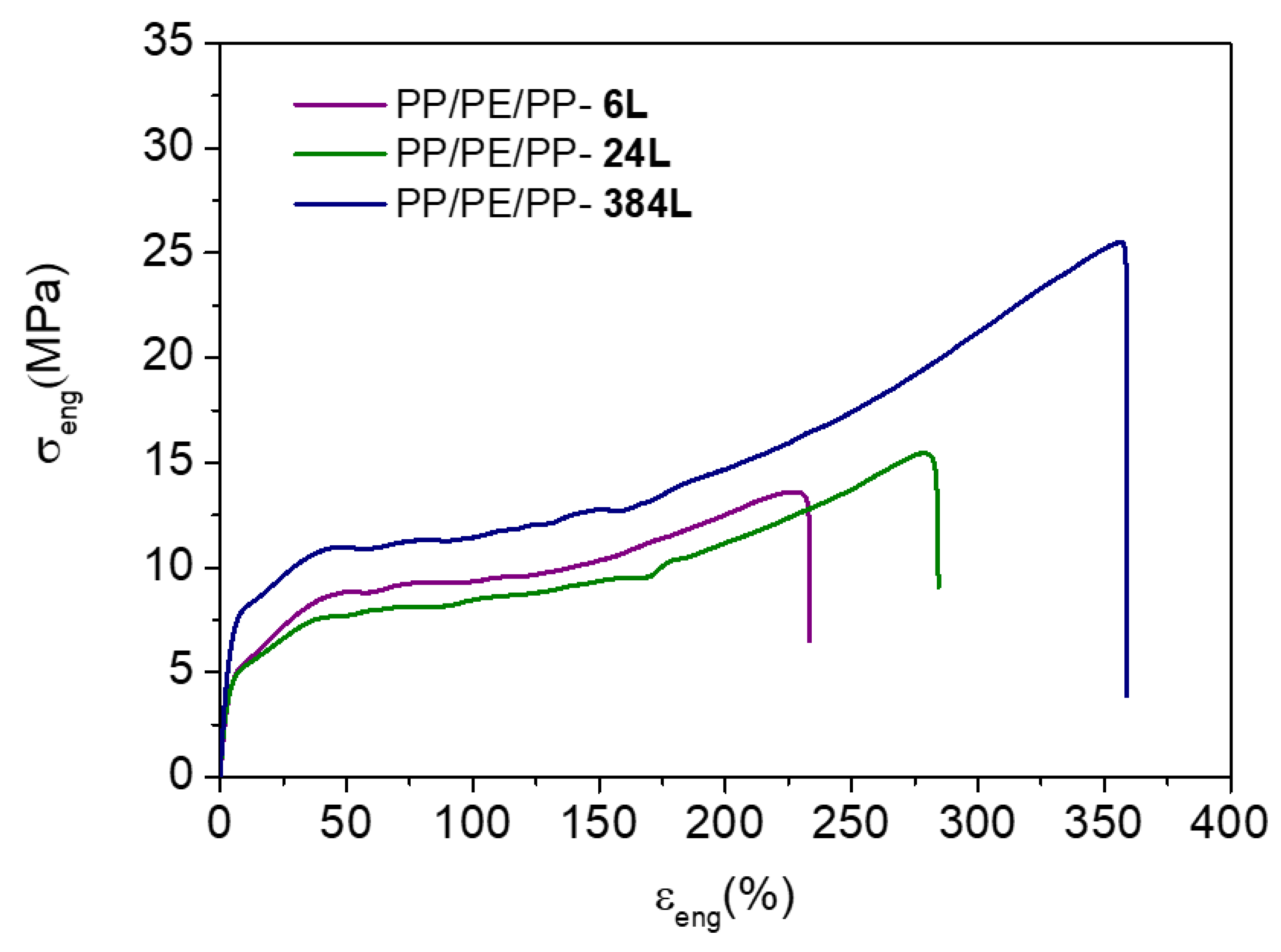


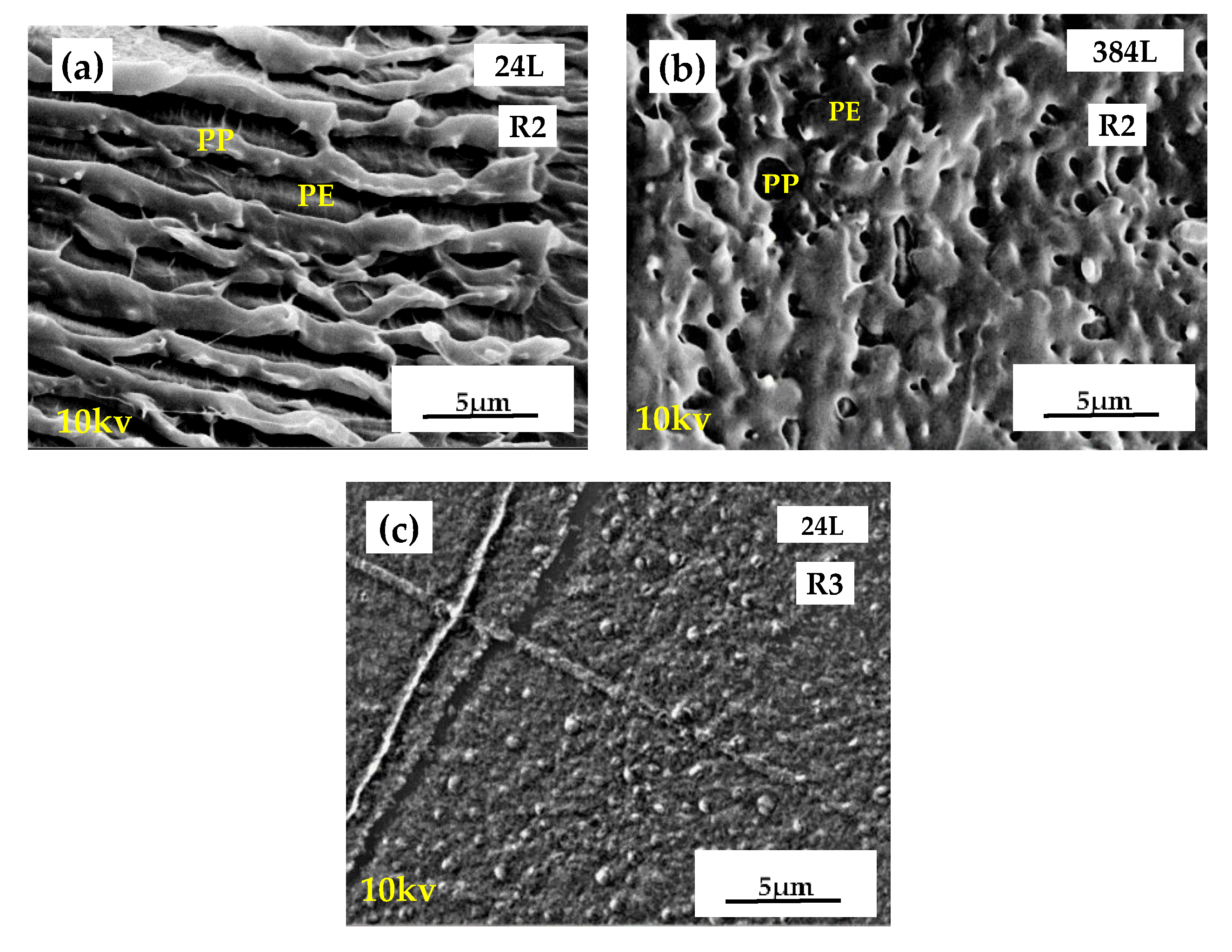
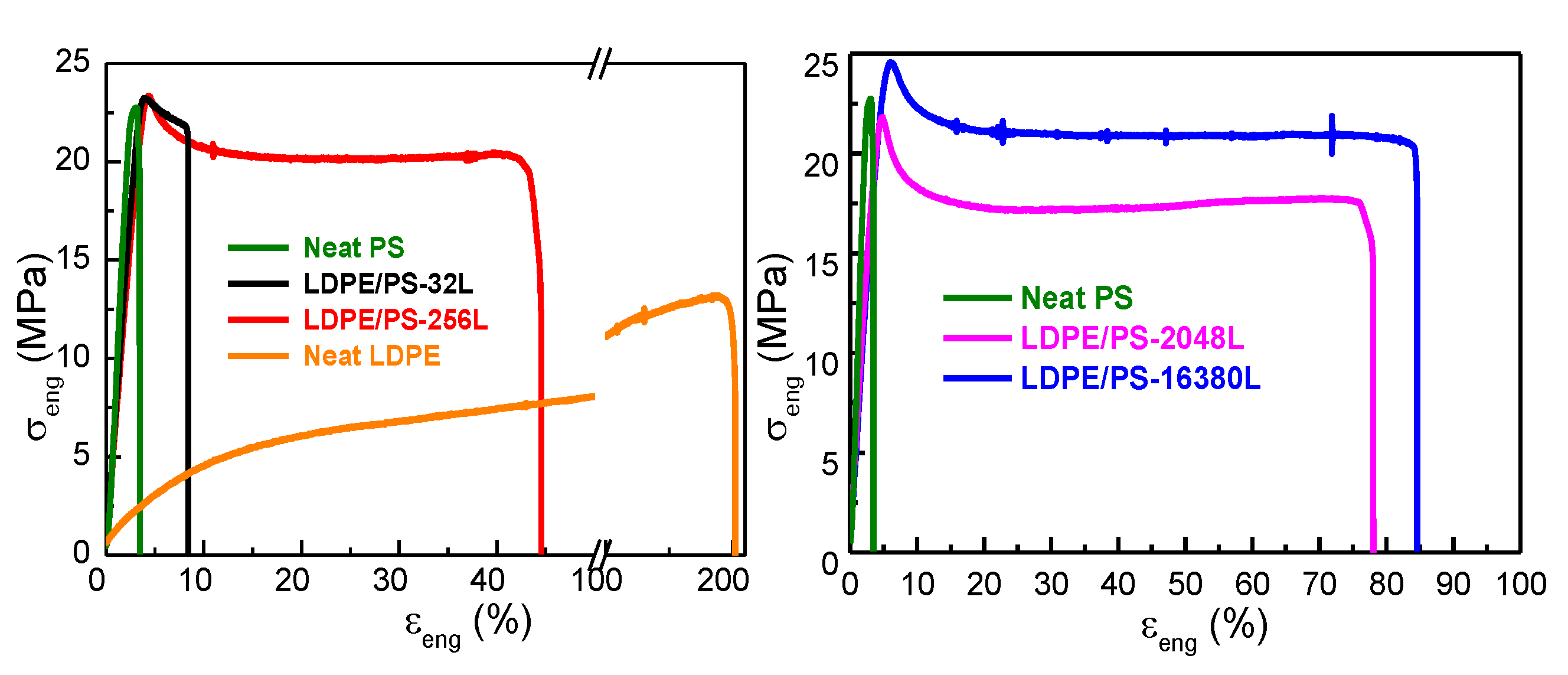

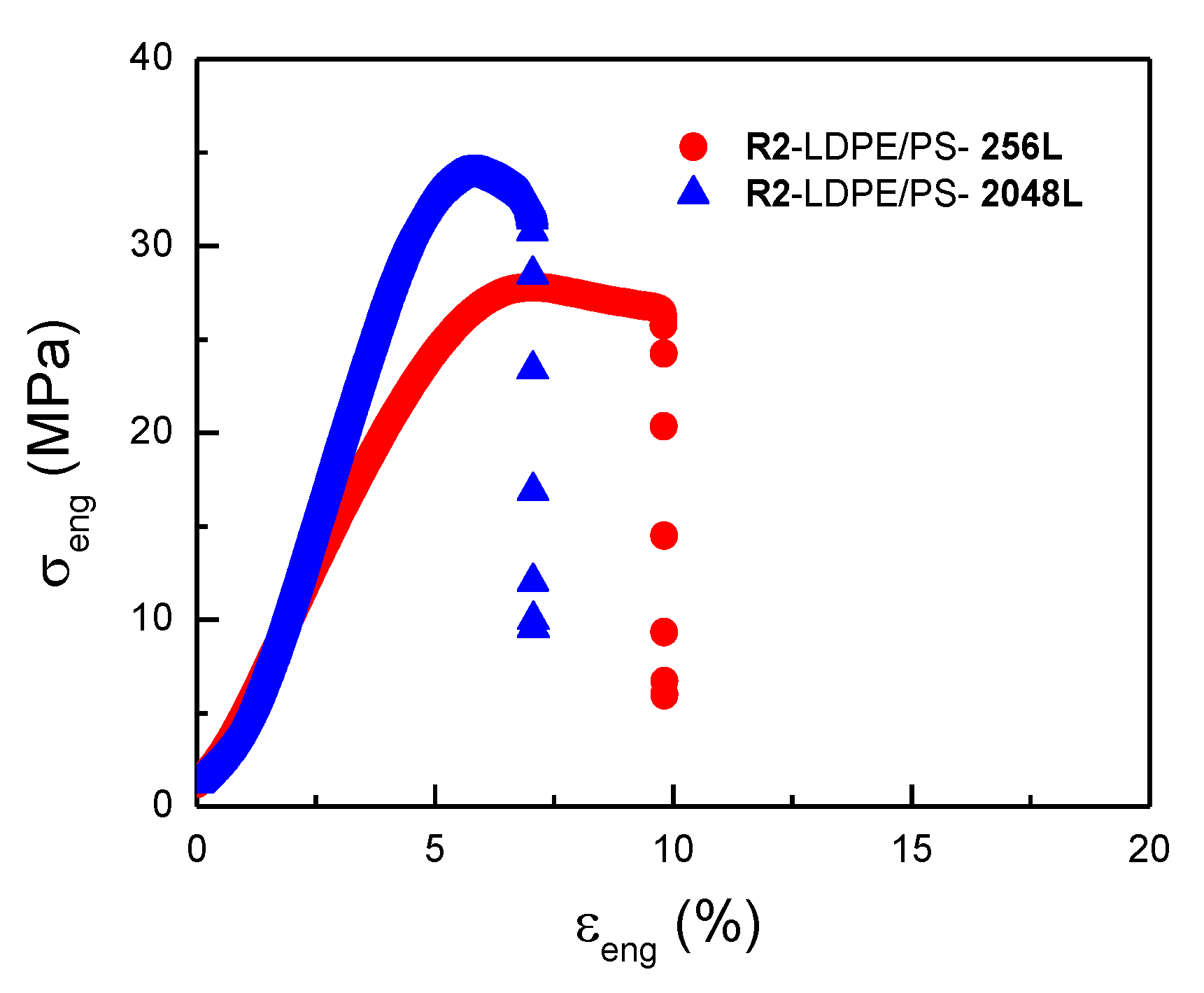
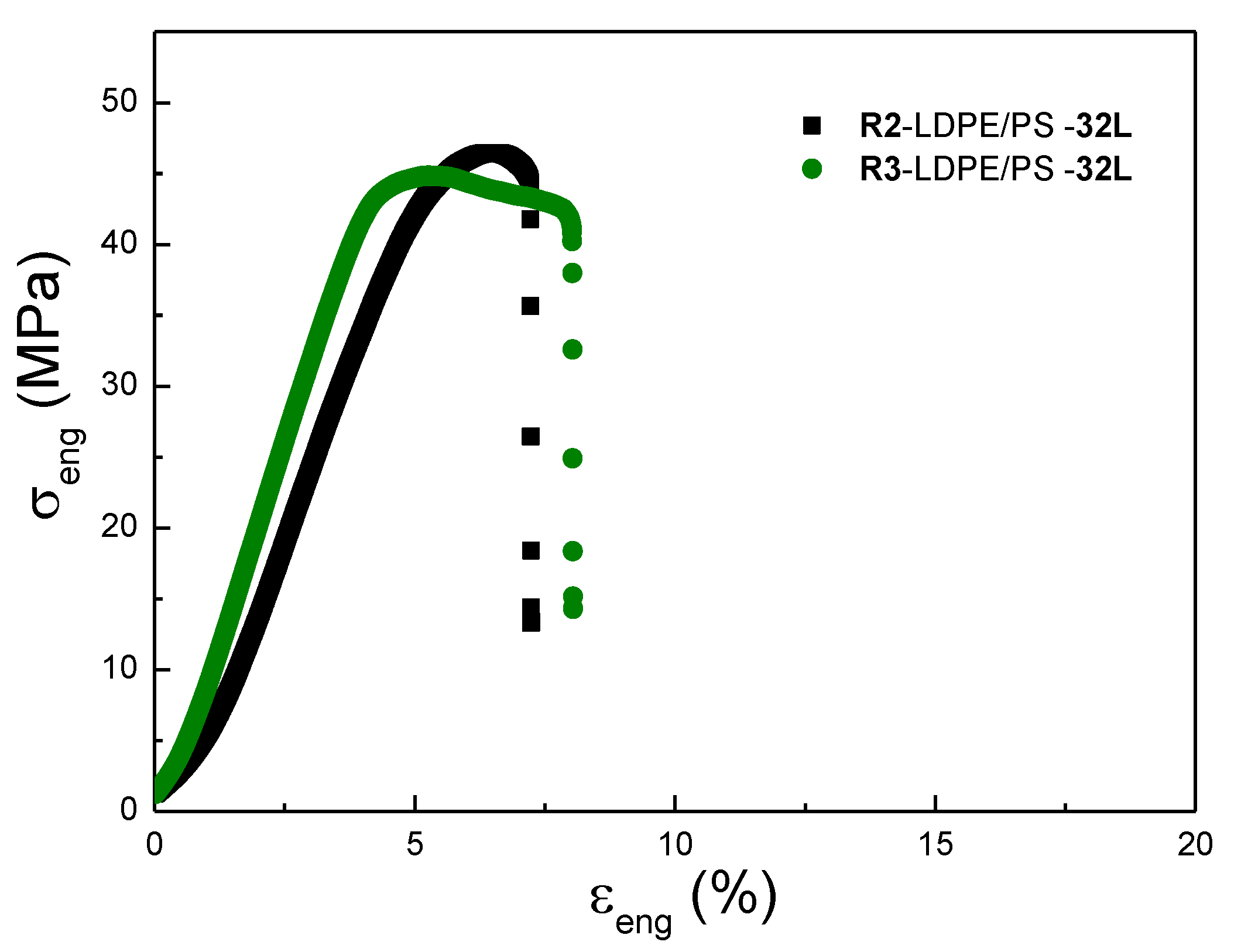

| Polymer | LLDPE | PP | EOC | LDPE | PS |
|---|---|---|---|---|---|
| Manufacturer | Chevron Phillips | LyondellBasell | Dow Chemical | ExxonMobil 165 | Crystal 637 |
| Monomer type | Ethylene/1-Hexene Copolymer | Propylene/Ethylene Copolymer | Ethylene/Octene Copolymer | ||
| Density (g/cm3) | 0.918 | 0.900 | 0.875 | 0.922 | 1.05 |
| MFI (g/10 min) | 1.0 a | 0.85 b | 1.0 a | 0.33 a | 4 c |
| Films | Volumetric Flow (v/v) | Number of Multipliers (n) | Number of Layers (N) | Total Thickness(µm) | Nominal Layer Thickness (nm) B/A/B Configuration | |
|---|---|---|---|---|---|---|
| A | B | |||||
| PE/PP systems | ||||||
| PP/LLDPE/PP | 90/10 | 1 | 6 | 200 | 50,000 | 25000 |
| 3 | 24 | 210 | 23,625 | 1313 | ||
| 7 | 384 | 250 | 1758 | 98 | ||
| PP/LLDPE + EOC/PP | 3 | 24 | 210 | 23,625 | 1313 | |
| 7 | 384 | 250 | 1758 | 98 | ||
| Films | Volumetric Flow (v/v) | Number of Multipliers (n) | Number of Layers (N) | Total Thickness (µm) | Nominal Layer Thickness (nm) B/A Configuration | |
| A | B | |||||
| PE/PS systems | ||||||
| LDPE/PS (10/90) | 10/90 | 4 | 32 | 200 | 1250 | 11,250 |
| 7 | 256 | 156 | 1406 | |||
| 10 | 2048 | 20 | 176 | |||
| 13 | 16,384 | 3 | 22 | |||
| LDPE/PS (50/50) | 50/50 | 4 | 32 | 6250 | 6250 | |
| 7 | 256 | 781 | 781 | |||
| 10 | 2048 | 97 | 97 | |||
| 13 | 16,384 | 12 | 12 | |||
| Multilayer Films | Tensile Strength at Yield (MPa) | Tensile Strength at Break (MPa) | Elongation at Break (%) |
|---|---|---|---|
| PP/LLDPE/PP-6L | 5.5 ± 1.7 | 13.5 ± 3.3 | 234.7 ± 20.0 |
| PP/LLDPE/PP-24L | 4.5 ± 0.5 | 15.5 ± 1.3 | 284.5 ± 27.4 |
| PP/LLDPE/PP-384L | 8.3 ± 1.2 | 25.6 ± 4.0 | 355.5 ± 28.0 |
| PP/LLDPE + EOC/PP-24L | 4.3 ± 1.0 | 20.6 ± 2.5 | 331.5 ± 18.1 |
| PP/LLDPE + EOC/PP-384L | 5.9 ± 1.6 | 22.4 ± 2.5 | 351.1 ± 23.0 |
| Recycled Samples | Tensile Strength at Yield (MPa) | Tensile Strength at Break (MPa) | Elongation at Break (%) |
|---|---|---|---|
| Monolayer film | |||
| R1-PP/LLDPE/PP-24L | 6.3 ± 1.3 | 15.5 ± 3.5 | 213.7 ± 20.0 |
| Tensile test rectangular specimen | |||
| R2-PP/LLDPE/PP-24L | 10.0 ± 0.5 | 20.3 ± 0.2 | 140.5 ± 14.2 |
| R3-PP/LLDPE/PP-24L | 10.8 ± 0.3 | 18.1 ± 0.1 | 120.3 ± 11.0 |
| Films | Tensile Strength at Yield (MPa) | Tensile Strength at Break (MPa) | Elongation at Break (%) |
|---|---|---|---|
| LDPE/PS-32L | 22 ± 2.8 | 22 ± 2.2 | 8 ± 2.4 |
| LDPE/PS-256L | 22 ± 6 | 20 ± 2 | 45 ± 18 |
| LDPE/PS-2048L | 22 ± 2.6 | 18 ± 2.6 | 78 ± 27 |
| LDPE/PS-16380L | 24 ± 2.2 | 20 ± 2 | 84 ± 20 |
| Films | Tensile Strength at Yield (MPa) | Tensile Strength at Break (MPa) | Elongation at Break (%) |
|---|---|---|---|
| LDPE/PS-32L | 20 ± 3.2 | 20 ± 3 | 4 ± 0.5 |
| LDPE/PS-256L | 18 ± 0.5 | 17.5 ± 1 | 16 ± 14 |
| LDPE/PS-2048L | 18 ± 1.1 | 14 ± 1.5 | 14 ± 3 |
| LDPE/PS-16380L | 22 ± 2.6 | 19 ± 2 | 45 ± 14 |
Publisher’s Note: MDPI stays neutral with regard to jurisdictional claims in published maps and institutional affiliations. |
© 2021 by the authors. Licensee MDPI, Basel, Switzerland. This article is an open access article distributed under the terms and conditions of the Creative Commons Attribution (CC BY) license (http://creativecommons.org/licenses/by/4.0/).
Share and Cite
Cabrera, G.; Touil, I.; Masghouni, E.; Maazouz, A.; Lamnawar, K. Multi-Micro/Nanolayer Films Based on Polyolefins: New Approaches from Eco-Design to Recycling. Polymers 2021, 13, 413. https://doi.org/10.3390/polym13030413
Cabrera G, Touil I, Masghouni E, Maazouz A, Lamnawar K. Multi-Micro/Nanolayer Films Based on Polyolefins: New Approaches from Eco-Design to Recycling. Polymers. 2021; 13(3):413. https://doi.org/10.3390/polym13030413
Chicago/Turabian StyleCabrera, Geraldine, Ibtissam Touil, Emna Masghouni, Abderrahim Maazouz, and Khalid Lamnawar. 2021. "Multi-Micro/Nanolayer Films Based on Polyolefins: New Approaches from Eco-Design to Recycling" Polymers 13, no. 3: 413. https://doi.org/10.3390/polym13030413








